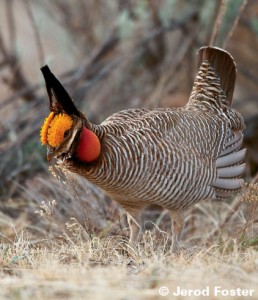Lesser Prairie-chicken numbers increase again
The Lesser Prairie-chicken population increased approximately 25 percent from 2014 to 2015, according to the recent range-wide aerial survey. Wildlife biologists with the Western Association of Fish and Wildlife Agencies (WAFWA) attribute the increase to abundant spring rainfall and ongoing efforts associated with the Lesser Prairie-chicken Range-wide Conservation Plan.
Increases were observed in three of the four ecoregions across five states – Colorado, Kansas, New Mexico, Oklahoma and Texas – where the species exists. The Sandsage Prairie Region of southeast Colorado showed the biggest gain – approximately 75 percent from a year ago. The Mixed Grass Prairie Region of the northeast Panhandle of Texas, northwest Oklahoma and southcentral Kansas showed an increase of approximately 30 percent, and the population in the Shortgrass Prairie Region of northwest Kansas grew by about 27 percent.
“An overall 25 percent increase in the Lesser Prairie-chicken population across its five-state range is welcome news,” said Ross Melinchuk, chairman of WAFWA’s Lesser Prairie-chicken Initiative Council. “This year’s increase, on the heels of last year’s 20 percent increase, is evidence of the species’ ability to rapidly recover from downturns resulting from drought and poor range condition. With continued improvement in nesting and brood-rearing habitat associated with abundant rainfall and private landowner actions to conserve and restore their habitat, we are optimistic the species will recover to historic population levels.”
The only ecoregion with a continued downward population trend is the Shinnery Oak ecoregion of eastern New Mexico and western Texas. This ecoregion is still recovering from a prolonged period of drought. However, recent roadside surveys indicate Lesser Prairie-chickens in this area are starting to respond to rainfall that occurred in late 2014 and early 2015.
“We’re confident that with continued moisture and drought relief, next year’s Shinnery Oak populations should continue to recover,” said Bill Van Pelt, WAFWA grassland coordinator.
The nonprofit WAFWA is coordinating efforts established under the Lesser Prairie-chicken Range-wide Conservation Plan, which is an initiative designed to engage private landowners and industry to conserve Lesser Prairie-chicken habitat and minimize impacts to the species. To date, industry partners have committed $46 million in enrollment fees to pay for mitigation actions, and landowners across the range have agreed to conserve nearly 100,000 acres of habitat through 10-year and permanent conservation agreements.
Companies, landowners, farmers and ranchers may still enroll in the range-wide plan and receive regulatory assurances that their operations can continue under an accompanying Certificate of Participation. Participating companies can continue operations under certain restrictions while providing funds to conserve Prairie-chicken habitat. To date, about 180 oil, gas, wind, electric and pipeline companies have enrolled about 11 million acres across the five states. Enrollment fees are deposited with WAFWA and administered to fund conservation efforts by private landowners to benefit the Lesser Prairie-chicken.
The Lesser Prairie-chicken was listed as threatened under the Endangered Species Act in May 2014. The final listing rule allowed private industry to develop and impact habitat if enrolled and participating in WAFWA’s range-wide plan, and it also provided various options that landowners can use to receive similar coverage. The range-wide plan provides incentives for landowners and industry to protect and restore habitat, which is important because they control much of the species’ range.
Organized in 1922, WAFWA represents 23 states and Canadian provinces, from Alaska to Texas and Saskatchewan to Hawaii – an area covering nearly 3.7 million square miles of some of North America’s most wild and scenic country, inhabited by more than 1,500 premier wildlife species.
More information, including the range-wide plan, is available on the WAFWA website at www.wafwa.org.

